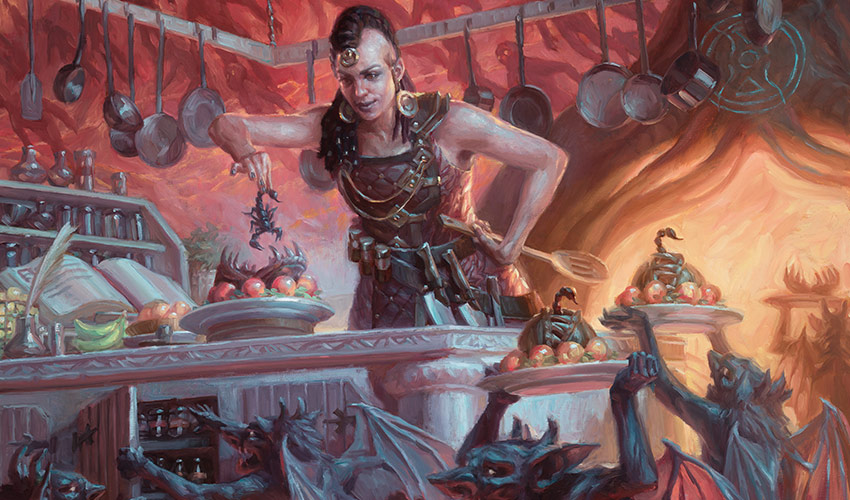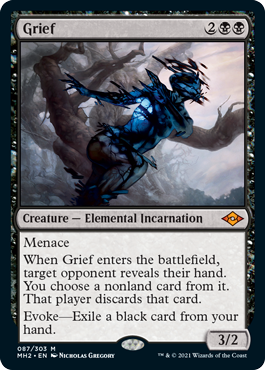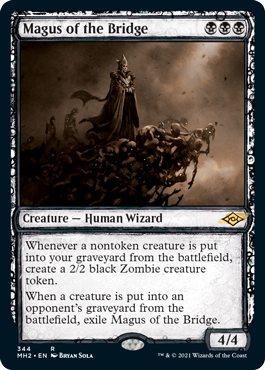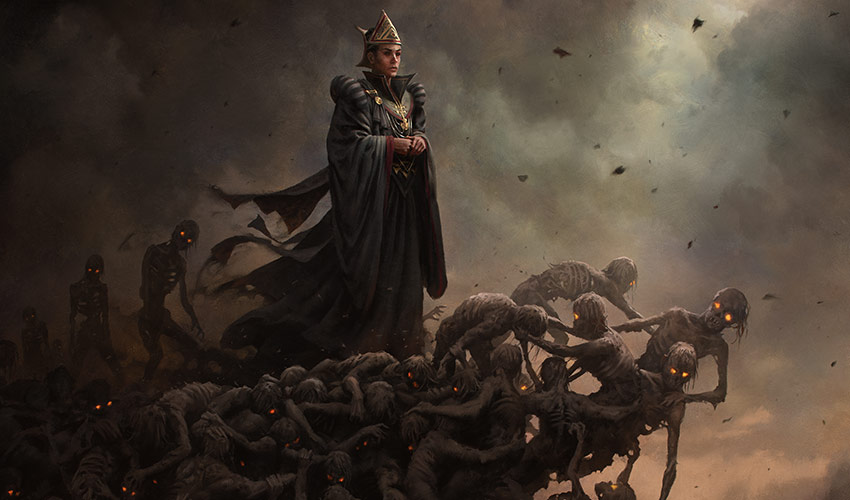Magus of the Bridge
Modern Horizons 2 is a celebration of so many things in the game. You have the deepest lore cuts brought to legendary life, indestructible lands to build impossible new decks with, and even a Squirrel army to wrangle.
So many cards tell a story that leads to asking more questions.

And some cards are answers to questions from a story outside of the set.
Dredging Up Details
There's a story every player will tell you if you ask: their own. How did you start playing? What kind of Magic do you like to play? Which Magic set do you think is the best to draft?
What's your favorite deck to play?
Erin Campbell has a story about finding her favorite deck. A community figurehead, she started with her (newly retired) podcasts—the interview-based The Deck Tease, then the group discussion driven The Girlfriend Bracket—before joining the team-up podcast Magic Mics. A veteran of the Magic Online Community Cup and three seasons of Vintage Super League, her renown and skill are synonymous with her nickname "Dredge Queen" for good reason: she is one.

And if you followed her on Twitter throughout Modern Horizons 2 preview season you already knew this.
Uhhh, this is better than Unmask in Vintage Dredge. You can get Bridge triggers out of this, it feeds Ichorid, and it can't be countered by FoN or Flusterstorm. WOW. https://t.co/WJY8Zz8F8o
— Erin Campbell (@OriginalOestrus) May 20, 2021
UMMMMM https://t.co/PCFyoRH4Pd
— Erin Campbell (@OriginalOestrus) May 20, 2021
GOT THERE FAM https://t.co/jgnhO9A37D
— Erin Campbell (@OriginalOestrus) May 27, 2021
Dredge is a perennial powerhouse in Modern, but Erin's journey to becoming a face of Dredge started simply: first picking it up. "I felt like I had taken Standard as far as you can go," she explained. Her local game store was where she played Standard first, but a hot new format was sweeping through that caught her eye. "I noticed that FNM has Modern, and the Modern portion was starting to get larger than Standard. I wanted to be part of that."
Her road into Modern was humble, building decks she could before finding comfort with a midrange deck. But one day, a deck in similar colors caught her attention. "In Standard, I played really fair black-green decks, but I had never done anything like a Living End combo deck."
Cascading into Living End, with a graveyard full of creatures, is a spectacle any player can appreciate—and Erin was hooked. "I couldn't go back after it," she said. "I just kept chasing this feeling and looking for it in different decks until someone was then like, 'Hey, have you tried Dredge?' And I was like, 'Ohhhhh!'"
"That started me on the journey to Dredge—and once you flip over half your library into your graveyard on turn two you just can't go back to casting a Tarmogoyf."
Dredge is a deck built off its namesake mechanic, dredge. The general plan is to take advantage of making your graveyard a resource by putting as many cards as possible into it, then leveraging abilities and triggers that benefit you because of that. Returning scores of creatures from the graveyard, building an instant and overwhelming army, and finding upside in recklessly digging through your deck at all things Dredge offers.
Magic teaches you to value your life total and play creatures for mana over time, but Dredge eschews all that by breaking those fundamental ideas and replacing them with combos that make your graveyard larger than your deck.
It feels totally different from the "normal" Magic every player learns—and it's liberating.
"It was about chasing a feeling. I've always played Magic to feel something," Erin said. "I need to love what I'm doing, and I spent a lot of time playing decks I didn't enjoy because I felt like I had to [to do well]."
"When I discovered Dredge, I was at a point in life where I wanted to do things because I wanted to. It feels like a secret I get to know," she said. "One of the things about Dredge is people like to say 'it's easy,' but they pick up Dredge and they don't know what they're doing. It really is like speaking a different language."
What makes Modern Dredge feel so different? The cards that shine brightest in Dredge are often unique from other decks.
"In Modern, Thrilling Discovery has been a great card. Thanks, Wizards!" Erin said. "The cards that Legacy wants are different from Vintage, and the Modern version is most likely to be casting things and actually playing their lands."
"Life from the Loam is the backbone of Modern Dredge. Shriekhorn is key, too. We look for the crazy commons and uncommons people otherwise don't want," she said. "Conflagrate and Ox of Agonas were pretty great things for us in Modern Dredge, too. I would say those are unique to Modern Dredge."
With a history in the format dating back to its inception and Pro Tour Philadelphia debut in 2011, Dredge has seen cards come and go. Dread Return has always been banned from the start, but Golgari Grave-Troll had a brief return before heading the way of the chopping block. Faithless Looting was the latest loss, and Bridge from Below bit the dust because of the dominance a single card caused by 2019's Modern Horizons.
The summer of 2019 was a gamechanger for Dredge when Hogaak, Arisen Necropolis arrived, and leaning into it quickly propelled decks leaning into it into combo decks that dominated Modern.
Which is exactly what Dredge players do with Dredge decks.
"I think like a lot of players, Dredge players were like 'How can we break this?' since when you speak a language others don't," she said, "you see things differently."
There are always new cards that target graveyard interactions or look to level them up. Dredge carries on regardless—it simply is. "I remember seeing Silent Gravestone previewed and Magic Mics listeners thinking I would be mad about it—but I wasn't," she said. "I don't target anything in graveyards." It simply wasn't the kind of resistance that mattered for her to win with Dredge.
But Hogaak was different. "With Hogaak, it was 'Challenge Accepted!' and we knew this was something we would use but we had no idea it would turn into something that would have profound implications the format," Erin recalled. "Leyline of the Void was the most played card in the main deck [at Mythic Championship IV]—to see Dredge that dominant was unheard of."
And that was after Bridge from Below was banned to put a damper on the explosive power and effectiveness of Hogaak Dredge.
While the ubiquity of Dredge in Modern led to homogenization for play—and Hogaak's ban—it didn't slow Erin down from enjoying Dredge for Dredge's sake. "The nice thing about Dredge is you can play it in multiple formats. When the hate is too strong, you can take your ball and go play elsewhere," she said.
And even if you don't, there's power in being the number-one villain players prepare against. "When Leyline of the Void is everywhere, you know exactly what you're getting. You know what you need to bring in from your sideboard," she explained. "When you don't know what they have, you sometimes play this guessing game on what they could be bringing in." That predicability and clarity, when you see how the game shapes up, is something Erin appreciates. "There's also something freeing to know you've done everything you could have done and they just have Leyline of the Void, and Yixlid Jailer, and Ravenous Trap. What can you do? Sometimes they just want it more."
Even through it all, after losing Hogaak, Golgari Grave-Troll, and now Faithless Looting, it's "still business as usual. We're still here."
Which comes full circle back to Modern, and now Modern Horizons 2.



Plenty of potential new friends for Dredge arrive soon, with the most direct callback to a banned card also looking to go where Dredge players may take it.


"That's bananas." Erin truly does speak like her tweets.
"Modern Dredge never really played with Bridge, even its early days," she said. "While Hogaak put Bridge from Below front and center, it wasn't the key component in that deck's success as the events that followed showed. Hogaak actually got better after they banned Bridge. Folks have played around with Vengevine builds, but I don't think this is something Dredge would necessarily want. But in longer games or games where ytou anticipate a lot of removal, this could come in and can just go. I could also see this in a Zombies or black-green Yawgmoth, Thran Physician deck."
"Our enablers really stop at two mana, like Cathartic Reunion. The things we're casting have to be amazing, as you're paying two mana to blow through your deck and draw up to 15 cards. Magus of the Bridge requires some setup," she said. "Modern Dredge is really comprised of two parts: the things you do in the beginning to get going, like Shriekhorn or Life from the Loam, and then thing things you do to close out the game like Ox of Agonas. We really don't have much middle ground."
But that can change on a dime, as Dredge always evolves with the cards and metagame. "With Altar Of Dementia, Bloodghast, and Vengevine, I could see something like the Hogaak deck without the Hogaak: a really 'fair' Altar Of Dementia deck." You could hear the smile in her voice. "I would play that."
And that's the point Erin kept coming back to. Dredge is Dredge, whatever it dredges, and that bridges so many ways to make the graveyard a terrifying pile for opponents regardless of the cards used.
"The power of Dredge is to keep coming back again and again. It's possible 'the Hogaak deck' is the same way," Erin said. "That's one of the things I love about Dredge is its resilience. All it takes is one event for people to let down their guard and skimp on graveyard hate, and suddently you're back in the game."

Once Modern Horizons arrives—on Magic Online June 3 and at your local game stores June 18—it will be time again for the next wave of Dredge decks to emerge. And if you're a fan, you'll just need to heed your queen to know what that means for you.
